Words Amicia de Moubray Photographs Amicia de Moubray
Next time you are stuck in a roadblock in Ospringe sneak a glance at the Maison Dieu, stopping place of many kings as well as scores of pilgrims en route to Thomas Becket’s shrine in Canterbury, or the Holy Land. On the corner of Water Lane and the old Roman road Watling Street (now the A2), this once religious stopover now reverberates to the juddering of traffic.
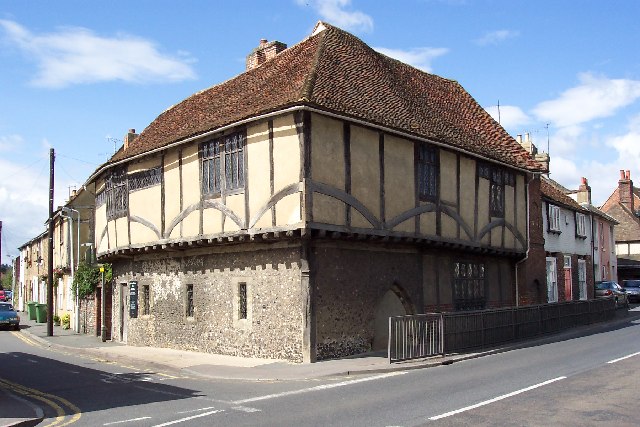
The ancient Maison Dieu, Ospringe
Commissioned by Henry III 1234, it is an astonishing survival. Stepping into the building one is transported back hundreds of years to visualise exhausted footsore pilgrims resting at their last stop before Canterbury. It is thrilling to be a whisper away from notable historical figures such as the Black Prince and Edward I.
Hospitals in the Middle Ages, as well as providing a resting place for weary pilgrims, were also often used for lepers, the poor and infirm, and as almshouses. The name derives from the Latin word for hospital and guesthouse. More than 700 hospitals were founded between the Norman Conquest and the 16th century in England.
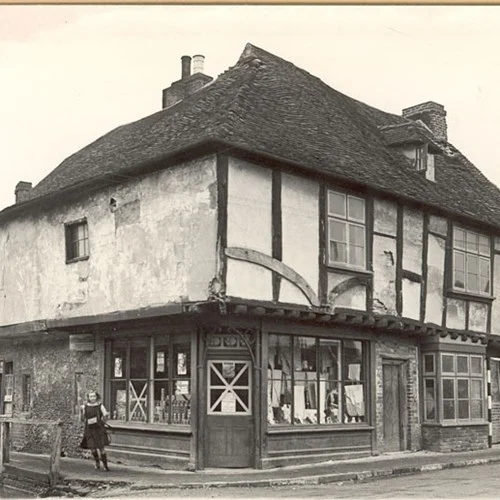
For a period the Maison Dieu was reincarnated as a shop
Dating from the 13th, 15th and 16th centuries, the flint and timber framed, jettied building is the only remaining building of what was a large complex of the Hospital of the Blessed Mary of Ospringe. Other buildings included a camera regis, a chamber reserved for the use of visiting royalty to conduct royal and state affairs, an eight-bay infirmary hall with a central arcade on octagonal piers, and a chapel.
‘Evidence of the gatehouse still remains in the carpark of the Ship Inn,’ says Ann Wilkinson of the Maison Dieu Museum Trust, and a passionate devotee of the Ancient Monument.
The main buildings lay to the north of the A2. Originally the road was to the south of the Maison Dieu. It is not known when it was realigned. The whole was staffed by brethren of the Holy Cross governed by the rule of St Augustine of Hippo.
There is much to delight including the Great Chamber with its fine kingpost roof, now home to a splendid array of local Roman remains and many other interesting finds from several 20th century archaeological excavations.
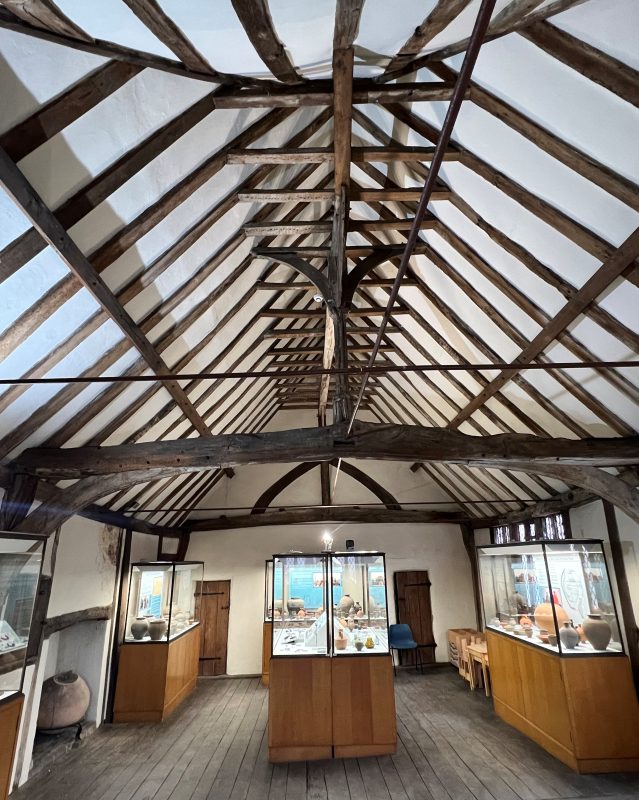
The Great Chamber
Looking down into the undercroft, one feels as if one is descending into the bowels of the earth. It is a world away from the 21st century hurtling by just yards away. In the past it was almost certainly under water for long periods, being situated at a point in Ospringe where the then flowing Westbrook widened to a fordable stream before eventually wending its way to Stonebridge pond and Faversham Creek.
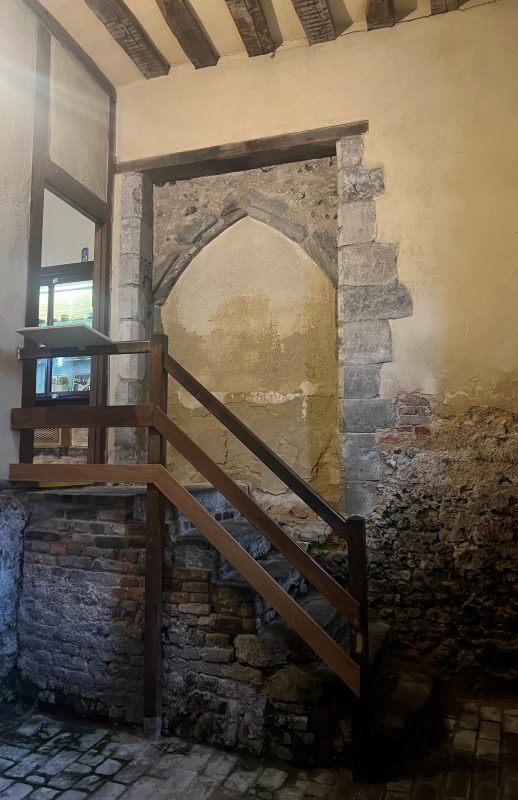
The door frame that was re-instated in the 1950s. Luckily it was saved when it was taken away to make room for a shop front in 1894
John Fisher, Bishop of Rochester 1459-1535, persuaded Henry VIII to dissolve the Maison Dieu in 1519 and grant its revenues to St John’s College, Cambridge.
The building’s history for the next few hundred years is obscure but a 16th century fireplace and a handsome late 16th century plaster ceiling in a ground floor room indicate that it was probably used as house at some point. In 1894 the Watling Street front and the forward part of the building above the undercroft were removed, making way for a shop front. Someone was wise enough to keep the door arch, which was reinstated in the 1950s.
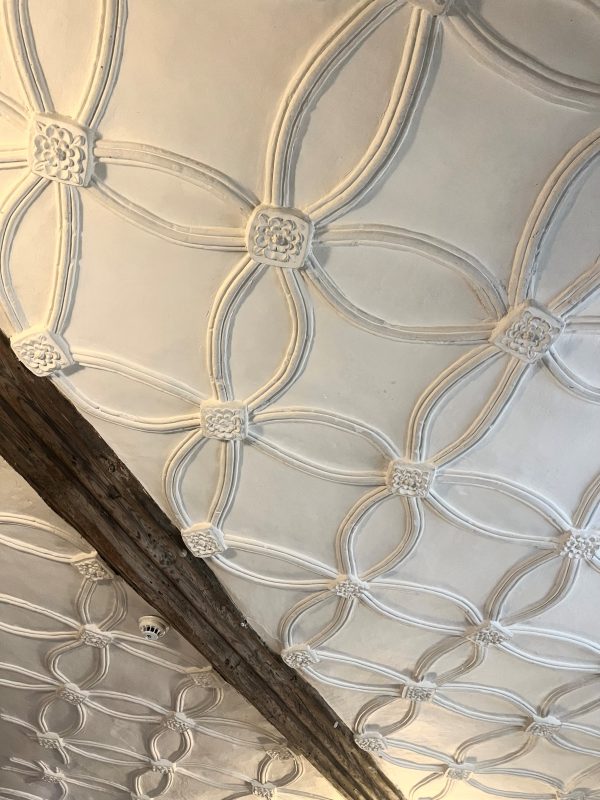
A 16th century plaster ceiling
When the M2 was built in 1963, twin culverts were installed under Water Lane to channel the excess water beneath the road and out toward the creek.
By the early 20th century, the building was in a considerable state of decay, and the local council was threatening demolition. In 1922 the building was condemned as unfit for human habitation, even though the lower floor was in use as a bakery.
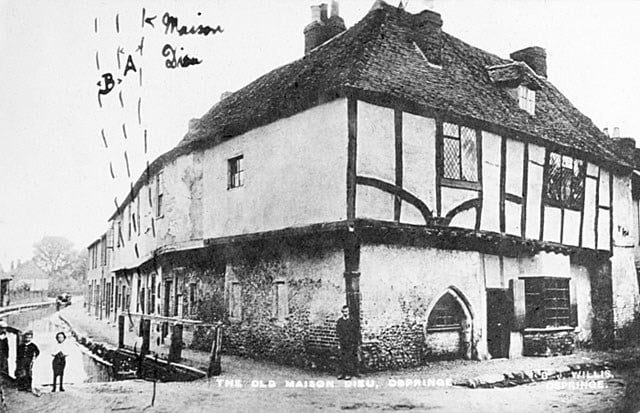
A historic image clearly showing Water Lane
Happily, William Whiting of Whiting brickworks located in Ospringe, a Fellow of the Society of Antiquaries, recognised the importance of the Maison Dieu. He was a considerable local figure – a teacher at Ospringe Primary School, an officer of the church, a member of the Parish Council, Hon Treasurer of the Faversham Institute, a keen member of the Photographic Society, and on the Council of the Kent Archaeological Society. Along with his brother John, they established a trust funded by donations from local residents to rescue the Maison Dieu. The upper floor was converted into a museum for the many Roman treasures he had found in the vicinity of Ospringe. William was the first curator, and his brother, the Secretary of the Trust. It became the first village museum in England in 1925.
Whiting along with two other scholars wrote a report on the excavation of the Roman cemetery undertaken in 1921 at Ospringe. It was published by the Society of Antiquaries in 1931.
The Maison Dieu is now managed by the Maison Dieu Museum Trust, 2 Water Lane, Ospringe, Kent ME13 8TS and staffed by volunteers. New volunteers are very welcome. For more information: annbw70@outlook.com.
Open Saturdays, Sundays and Bank Holidays 2-5pm from Good Friday until the end of October.
01795 601714.